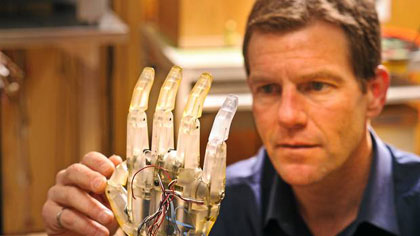UNB research contributes to world s first thought-controlled prosthetic leg
Author: Communications
Posted on Nov 22, 2012
Category: UNB Fredericton
It's been years of rese arch in the making and recently the groundbreaking bionic leg was put to the ultimate test when Zac Vawter climbed 103 flights of stairs to the top of Chicago's Willis Tower—one of the world's tallest skyscrapers.
arch in the making and recently the groundbreaking bionic leg was put to the ultimate test when Zac Vawter climbed 103 flights of stairs to the top of Chicago's Willis Tower—one of the world's tallest skyscrapers.
University of New Brunswick Alumnus, Levi Hargrove, the lead researcher at the Center for Bionic Medicine at the Rehabilitation Institute of Chicago, worked with Vawter for months prior to the smart leg’s first public launch.
Hargrove is a three-time UNB graduate and maintains close contact with his former UNB supervisors, Kevin Englehart and Bernie Hudgins, who were also instrumental in launching the world's first smart leg.
Research conducted by Englehart's students, Roua Razak and Dan Rogers from UNB's Institute of Biomedical Engineering, contributed to the sophisticated neural control of the smart leg.
The robotic leg is designed to respond to electrical impulses from muscles that remain in Vawter's amputated leg. When Vawter thought about climbing the stairs, the motors, belts and chains in his smart leg synchronized the movements of its ankle and knee.
The computerized prosthetic limb weighs about 10 pounds and uses two motors.
Bionic - or thought-controlled - prosthetic arms have been available for a few years, thanks to pioneering work done at UNB's Institute for Biomedical Engineering. Knowing leg amputees outnumber people who've lost arms and hands, Hargrove's research focuses more on lower limbs.
But, he says he would not be in the position he is today without the guidance and support of Englehart and Hudgins.
"They were true mentors in every sense of the word," said Hargrove. "I would not be in my position today without their support. They introduced me to the field of research, imparted their substantial knowledge, and arranged for my laboratory exchange with the Rehabilitation Institute of Chicago. Equally important, I felt that they valued and respected my contributions."
Englehart says that teaching is the greatest motivating factor for what he does—besides the promise of improving the quality of life for amputees.
"I feel privileged to have the opportunity to work with talented and motivated people like Levi,” said Englehart. "It was clear very soon after having met Levi that he was a natural leader. In addition to his intellect, he has the ability to see the most important, practical aspects of complex issues, and he has tremendous self-confidence in his abilities. He's also a very down to earth individual who works easily with others."
Hargrove says the work being performed at UNB's Institute of Biomedical Engineering is truly revolutionary and has been pushing the boundary of artificial limb control since the 1960s and continues to do so today.
"I chose to stay at UNB because I was encouraged to be part of their ground-breaking research," said Hargrove. "I was given opportunities to travel internationally to other leading laboratories and was introduced to many thought-leaders in the field."
Hargrove grew up in Bath, N.B, and was exposed to electrical engineering at a very young age, as his father and grandfather are both engineers. After taking a biomedical engineering course at UNB during his undergraduate years, he realized he had found the area in which he wanted to make a long-term career.
He and Englehart plan to continue working together for years to come.
"It's inevitable that we'll continue to work together," said Englehart. "We share the same goals, we complement each other’s strengths, and enjoy working together."
As for amputee Zac Vawter, his exceptional journey started with surgery in 2009. When Vawter's leg was amputated, a surgeon repositioned the residual nerves that normally would carry signals to the lower leg and sewed them to new spots on his hamstring. That is what allows Vawter to use a bionic leg.
The surgery is called "targeted muscle reinnervation" and it's like "rewiring the patient," Hargrove said in an interview with CBC. "And now when he just thinks about moving his ankle, his hamstring moves and we're able to tell the prosthesis how to move appropriately."
Experts far and wide agree that this research is leading edge.
Most artificial legs are passive. Others have motorized or mechanical components but don't respond to the electrical impulses caused by thought.
"This is a step beyond the state of the art," said Daniel Ferris of the University of Michigan in an interview with CBC. "If they can achieve it, it's very noteworthy and suggests in the next 10 years or so there will be good commercial devices out there."
The $8-million project is funded by the U.S. Department of Defense and involves Vanderbilt University, the Massachusetts Institute of Technology, the University of Rhode Island and the University of New Brunswick.
